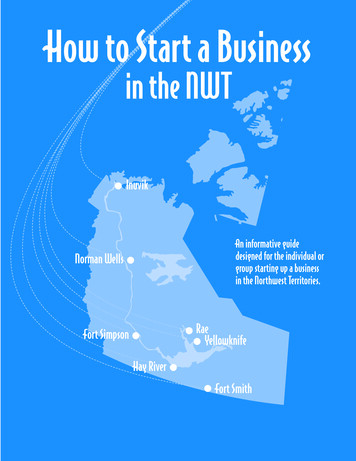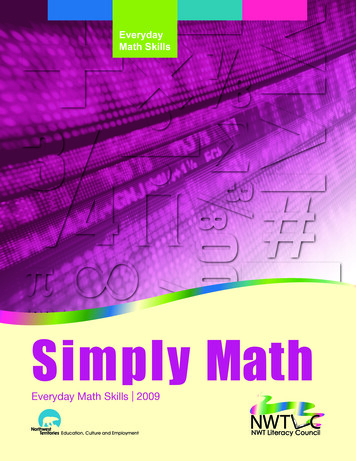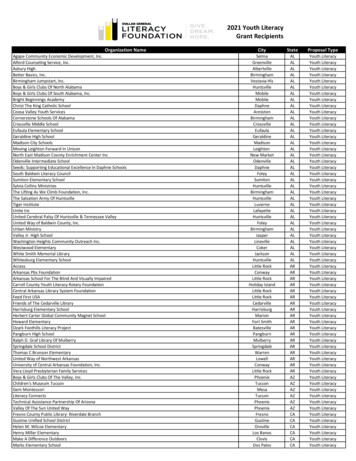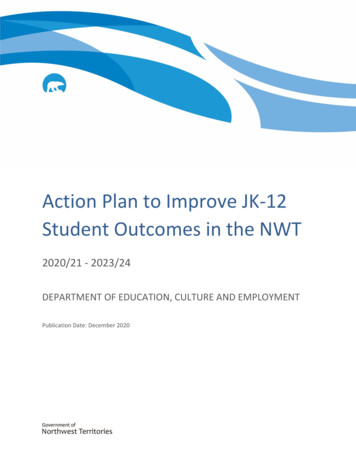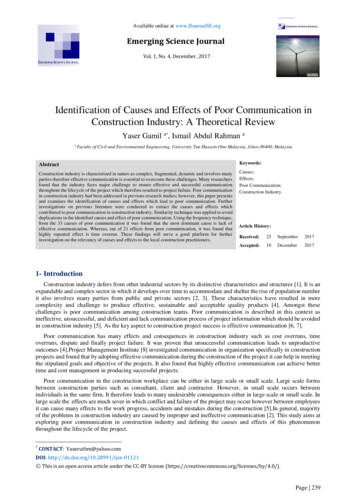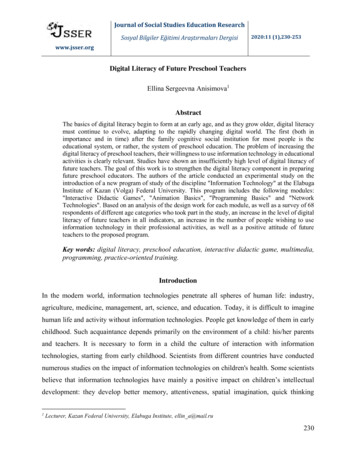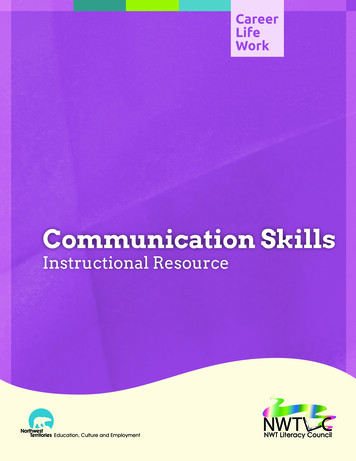
Transcription
CareerLifeWork
AcknowledgementsThe NWT Literacy Council gratefully acknowledges the financial assistance forthis project from the Department of Education, Culture and Employment,Government of the Northwest Territories.With thanks to Lisa Campbell for developing this resource for the NWT LiteracyCouncil.There are 10 manuals and workbooks in the Career – Life – Work series. Youwill find a list of them on the last page of this manual. You can find the wholeseries online at www.nwt.literacy.ca under the adult resources section. If youwould like print copies, please contact the NWT Literacy Council.Box 761, Yellowknife, NT X1A 2N6Phone toll free: 1-866-599-6758Phone Yellowknife: (867) 873-9262Fax: (867) 873-2176Email: nwtliteracy@nwtliteracy.caWebsite: www.nwt.literacy.caISBN: 978-1-896472-37-9 (November 2012)
Career – Life – WorkCareer Life WorkTable ContentsIntroduction . 3Communicating with Others . 5Communication Charades . 11Role Plays . 13Non-verbal Communication . 14Test Your Communication Skills . 16Importance of Clear Communication . 19Communication at Work . 22Assertiveness Quiz . 24Assertive, Passive, or Aggressive? . 27Active Listening . 31The Bug . 35What is Active Listening. 36Seven Simple Steps to Active Listening . 37Oral Presentations . 39Tips for Getting Over Your Fear. 44Oral Speaking Self-Assessment . 45One Minute Talks . 48Oral Presentations . 50Tips for Oral Presentations . 51Working with Others (Team Building) . 53Ten Qualities of an Effective Team Player . 61Communication SkillsCommunication Skills Instructional Resource11
Career – Life – WorkCareer Life WorkPersonality Type . 63Working With Others Self-Assessment . 65What Makes an Effective Team . 68Working with Others or Working Alone? . 69Working with Others in Work Situations . 71Dealing with Conflict . 73Conflict Quotes . 79Looking at Conflict in a Different Way . 81Causes and Responses to Conflict . 82Five Styles of Conflict Management . 83Using the Five Styles of Conflict Management . 86“Pick a Style Any Style” Conflict Game . 88Working through Conflict Using Collaboration . 90Steps to Working through Conflict . 94Workplace Conflict . 95Communication Skills2Communication Skills Instructional Resource2
Career – Life – WorkCareer Life WorkIntroductionDespite the Northwest Territories' strong economy and low unemployment rate,some workers continue to have difficulty obtaining or maintaining employment.According to researchers, one of the primary reasons is that they lack soft skills.Soft skills are non-technical skills, abilities, and traits like communication skillsand working well with others. People need these skills to function in a specificemployment environment.Studies reveal that a majority of entry-level jobs require these types of social andinterpersonal skills: employers rank communication skills as the number oneskill they want in an employee. Communication is really at the heart of doing agood job at work.Communication encompasses speaking, listening, oral presentations, workingtogether as a team and dealing with conflict. This section of our Career – Lfe –Work series incorporates these skills by using both personal and work relatedexamples and situations.Developing communication skills is not an easy task. We sometimes have tounlearn certain behaviours we have been taught as children. But we can learnthese skills with lots of practice and patience. This section has the followingtopics:1. Communicating with Others: what is communication, communication quiz,body language, communication at work, assertive behaviour versus passiveor aggressive behaviour2. Active Listening: listening to instructions, good listening techniques, practiceand improving your active listening skills3. Oral Presentations: public speaking, oral speaking self-assessment, oralpresentations, PowerPoint presentations, digital storytellingCommunication SkillsCommunication Skills Instructional Resource33
Career – Life – WorkCareer Life Work4. Working with Others: good team members, personality types, working withothers self-assessment, working with others in work situations, fun teambuilding activities5. Dealing with Conflict: definition of conflict, why do we have conflict, conflictmanagement, working through conflict, conflict at workThis is an instructional resource with handouts for learners to support theCareer-Life -Work curriculum at the 120 level. There are a lot of activities in eachsection. You do not need to do them all. Choose the ones that would be best foryour learners.We have also developed two workbooks to go with this section called Soft Skills for Work (personal qualities, communication skills, working withothers, problem solving skills) Dealing with ConflictYou can use these workbooks with this section or as stand-alone units. Theworkbooks have many of the same activities as in the manuals. Look for them onthe NWT Literacy Council’s website at www.nwt.literacy.ca if you do not haveprint copies.Shows instructor notes and activities for each topicShows learner handouts for each activity. Copy enoughhandouts before you start the activity.Communication Skills4Communication Skills Instructional Resource4
Career – Life – WorkCareer Life WorkCommunicating with OthersLearning Activity 18 Handouts1.1: Two truths and one lieThe instructor stands up and briefly describes three life experiences he or she hashad. Two are true and one is a lie. After you share these three stories, learnersvote on which one is a lie.Learners try to decide which is a lie, using both nonverbal clues and what theyalready know about the person. Everyone is polled and each person votes on theone they think is a lie. Each person takes a turn.When you are finished, ask learners how they deciphered the lie. What did theylook and listen for?1-2: What is Communication?Many people think that communicating is about talking to one another.Although speaking is one component of communication it is probably not themost important. Ask learners what are other components of communication.(Possible answers: listening, body language, reading, writing, texting, emailing,Facebook, etc.)Next ask learners to come up with a definition for communication. They can dothis in groups or on their own.“Communication is a process (either verbal or non-verbal) of sharing informationwith another person in such a way that he or she understands what you aresaying.” (Dr. H. Norman Writing)Communication Skills – Communication with OthersCommunication Skills Instructional Resource55
Career – Life – WorkCareer Life Work1-3: Communication Charades (handout)Cut out the slips of paper on the handout. Put them in a hat. Form two teamswith learners. Tell learners that they are going to play communication charades.They must act out the facial expression or gesture of the word or phrase on theslip of paper. Do an example with them – act out “bored.” Each team will get 45seconds to guess and if they don’t get it the other team gets one chance to saywhat it is. Give each team eight turns or as many turns as there are people oneach team. Give one point for a correct guess.Next, discuss this statement: “The most important thing in communication is tohear what isn’t being said.” What does this statement mean?One of the most important ways we communicate is through body language ornon-verbal communication. The way we sit in a chair, fold our arms, turn ourbody or focus our eyes will do more to tell another what we are thinking than thewords we use to express ourselves.Tell learners that communication is: 55% through body movements. 38% vocal (pitch and volume). 7% verbal (words we use).Does this surprise anyone?Ask learners to brainstorm the different forms of non-verbal communication. Tone of voice Eye contact (However, in some cultures eye contact is considered rude orintimidating.) Facial expression Body orientation, posture, and use of space Hand and arm gestures Use of attentive silenceCommunication Skills – Communication with Others6Communication Skills Instructional Resource6
Career – Life – WorkCareer Life Work1.4: Role Plays (handout)First play a simple game of charades using different feelings such as nervous,bored, tired, frustrated, happy, interested, sad, angry, tense, etc. Write thesewords on small slips of paper and put them in a hat or bowl. Learners pick oneout and act it out without using words. Other learners try and guess what feelingthe person is portraying. (Play this if you have not played communicationcharades from the previous activity).Next ask learners to get into pairs and choose one or two role plays on thehandout. Give them time to practice their role plays before they perform in frontof the class. Discuss each role play.1.5: Why is Reading Body Language Important? (handout)Why is reading body language so important? Read the following scenario out tothe class.ScenarioYou go into your boss’s office to ask for a raise, but she has a scowl on her faceand barely looks up when you enter her office. Maybe this is not a good time toask for a raise. In fact, it might even be harmful to your goal. What kind of reaction is likely if we ask for a raise anyway? What might happen if we decide to offer help by saying, “Is there anythingthat I can help you with?” Can you think of a situation where you were able to read the bodylanguage of someone? What did you do? How did it change yourapproach to this person?Learners read the handout in pairs and discuss and write down the possiblemessages that are being sent.Communication Skills – Communication with OthersCommunication Skills Instructional Resource77
Career – Life – WorkCareer Life Work1.6: Test Your Communication Skills (handout)Ask learners to take the quiz on the handout to test their communication skills.1.7: Importance of Clear Communication (handout)Stand at the front of the room and ask learners to give you specific instructionsfor making a peanut butter and jam sandwich. Be careful to do exactly what theyinstruct you to do. For example, if a learner says “Put peanut butter on one sideof the bread,” do nothing until the student says something like “Open the peanutbutter jar. Pick up a table knife in the hand you usually use.” You could then putpeanut butter only on the outside edge of the bread. The key to this activity is todo exactly what the learners tell you to do. Discuss the exercise using thesequestions:1. What types of instructions were you giving me?2. What types of instructions worked best?3. What type of instructions did not work?4. What would have worked better?5. What was it about the instructions that worked well?Ask learners to work in small groups to identify four occupations or jobs in thecommunity that require particularly good communication skills. Ask them todiscuss the kind of problem that might arise as a result of poor communicationskills.Go over the four important factors in communicating a message:1. Why and how? Why and how do people communicate? For example: inperson, on the phone, in meetings, through emails, face-to-face, etc.2. Information? What information needs to be communicated? For example:meeting times, budget information, confidential information, etc.Communication Skills – Communication with Others8Communication Skills Instructional Resource8
Career – Life – WorkCareer Life Work3. Who? Who are people communicating with and what are the circumstances?For example: to a supervisor, co-worker, manager, team, meetings, patient,etc.4. Risk of Failure: What are the consequences of communication failure? Forexample: low-risk, potential money losses, or “life or death”.Learners, in groups, read one scenario on the handout and decide on how themessage will be delivered using the four important factors for communicating amessage.1.8: Communication at Work (handout)Give out the handout and ask learners to decide if each statement illustratesgood or poor communication skills. Change the statement to reflect goodcommunication skills.1.9: Being Assertive (handout)Assertiveness is standing up for your rights while respecting the rights of others.For example if you are bothered by someone’s smoking, you can ask them tostop. Can you do it in a polite way? Being assertive can sometimes be hardespecially if we were brought up to never speak up for ourselves.Take the Assertiveness Quiz AssertiveQuiz.html to seehow assertive you are. You can also do the quiz on the handout. Learners canshare their results with others in the class. Ask them how they think they can bemore assertive.1.10: Assertive, Passive, or Aggressive? (handout)What does it look like to be assertive? The handout shows some commonscenarios, with examples of each style of behavior. Read over the examplescenarios together as a class. Ask learners to break into four groups. Each groupCommunication Skills – Communication with OthersCommunication Skills Instructional Resource99
Career – Life – WorkCareer Life Workcan take one scenario and come up with an assertive, passive and aggressiveresponse for each situation. Each group reads their scenario and shares theirresponses with others in the class. You could also do this as a role play.At the end of the class, ask learners how they can be more assertive. Ask them tocome up with one action plan for themselves.Communication Skills – Communication with Others10Communication Skills Instructional Resource10
Career – Life – WorkCareer Life WorkCommunicating with OthersLearning Activity 1.3Communication CharadesTiredEverything’s okayAngryCome onPleasedStopSadThat’s enoughConfusedTell me moreInterestedWait a minuteSorryGo awayExcitedNo wayCommunication Skills – Communication with OthersCommunication Skills Instructional Resource1111
Career – Life – WorkCareer Life ication Skills – Communication with Others12Communication Skills Instructional Resource12
Career – Life – WorkCareer Life WorkCommunicating with OthersLearning Activity 1.4Role Plays1. Mother faces her child with arms crossed and eyes glaring while saying,“You’re such a sweet child.”2. Applicant sits slumped in a chair with eyes on the floor and whispers that heis really interested in the job.3. Grandmother hugs her grandchild while saying, “I love you!”4. Student sits in class and doodles with a glassy-eyed stare. The teacher asksher why she is not paying attention and she replies, “I am paying attention.”5. Santa looks at the little girl on his lap and says without a smile, “So, tell meagain what you wanted for Christmas.”6. Mary’s husband continues to watch the hockey game on TV while saying“Sure, honey, let’s talk.”7. Applicant approaches the job interviewer with a big smile and a firmhandshake and looks directly into her eyes and says, “I’m so happy to meetyou.”8. A friend, near tears, says, “Oh don’t worry about it.”Communication Skills – Communication with OthersCommunication Skills Instructional Resource1313
Career – Life – WorkCareer Life WorkCommunicating with OthersLearning Activity 1.5Non-verbal Communication1In the following work situations, what possible messages are being sent?1. A customer approaches the counter where you are standing. You greet thecustomer by smiling and saying, “Good morning.” The customer does notlook at you or respond to your greeting.2. As you approach a table of two in your restaurant, you notice one of thecustomers looking at his watch. His movements appear hurried and he istalking very quickly.3. You greet your boss and she smiles back at you.1Ready to Work North Workbook (p.137)Communication Skills – Communication with Others14Communication Skills Instructional Resource14
Career – Life – WorkCareer Life Work4. You ask a customer how her meal was and she says, “OK,” with a strangelook on her face.5. Four customers are sitting at the bar laughing and talking loudly.6. You come in late for work and you say hello to your boss. He grunts a quickgreeting and then returns to his work.7. You forgot to turn off a valve at work. Your co-worker comes in and turns offthe valve and then grins and shrugs his shoulders.Communication Skills – Communication with OthersCommunication Skills Instructional Resource1515
Career – Life – WorkCareer Life WorkCommunicating with OthersLearning Activity 1.6Test Your Communication Skills2OftenSometimesNever1. I can detect the mood of others bylooking at them when we talk.2. I can tell when someone doesn’tunderstand what I am saying.3. I am able to discuss issues withoutgetting upset.4. I find it easy to understand someoneelse’s point of view.5. When talking to people, I pay attentionto their body language.6. When I am angry, I admit it.7. I express my ideas clearly.8. I change the way I talk depending onwho I’m speaking to.9. I express my opinions even if others donot agree.2http://www.queendom.com/queendom tests/transferCommunication Skills – Communication with Others16Communication Skills Instructional Resource16
Career – Life – WorkCareer Life Work10. I can talk about my feelings.11. When I know what someone is going tosay I finish the sentence for them.12. I have difficulty putting my thoughtsinto words.13. I fidget while listening to someone talk.14. People don’t understand what I amtalking about.15. I find it hard to express my feelings toothers.16. People tend to misinterpret what I say.17. I have to repeat myself often becausepeople don’t understand what I amsaying the first time.18. I find it difficult to understandsomeone when they have a differentpoint of view from me.19. If I have something relevant to add, I'llinterrupt someone to make certain myviews are heard.20. When other people become emotionalaround me, I’m not sure how to react.21. If I find a conversation boring, I’ll letmy mind drift away.Communication Skills – Communication with OthersCommunication Skills Instructional Resource1717
Career – Life – WorkCareer Life Work22. I will stop a speaker in mid-sentence ifI disagree with a statement he or shehas made.23. People complain that I don't appear tobe listening when they speak to me.24. I tend to do most of the talking inconversations.25. I find myself struggling to find theright words to express myself.Calculate your score!Questions 1 - 10Questions 11- 253 points for Often0 points for Often2 points for Sometimes2 points for Sometimes0 points for Never3 points for NeverTotal ATotal BTotal A plus Total B 50 - 75: You are an excellent communicator!25 - 50: You have fairly good communication skills but still need some help.0-25: You need some help with your communication skills!Communication Skills – Communication with Others18Communication Skills Instructional Resource18
Career – Life – WorkCareer Life WorkCommunicating with OthersLearning Activity 1.7Importance of Clear Communication3There are four important factors in communicating a message:1. Why and how? Why and how do people communicates? For example: inperson, on the phone, in meetings, through emails, face-to-face, etc.2. Information? What information needs to be communicated? For example:meeting times, budget information, confidential information, etc.3. Who? Who are people communicating with and what are the circumstances?For example: to a supervisor, co-worker, manager, team, meetings, patient,etc.4. Risk of Failure: What are the consequences of communication failure? Forexample: low-risk, potential money losses, or “life or death”.Read the following scenarios on the next two pages and discuss how you shouldcommunicate the message using the above four important toESSENTIALSKILLS.pdfCommunication Skills – Communication with OthersCommunication Skills Instructional Resource1919
Career – Life – WorkCareer Life WorkScenario 1Sarah needs to communicate to her co-workers about a meeting that is comingup where several MLAs and the Premier will attend. There will be a largefunding announcement for the community’s Friendship Centre.Discuss:1. Purpose and Mode: How should Sarah communicate this information?2. Information Complexity: What information should be shared?3. Communication Context: Who should she communicate this information to?4. Risk of Failure: What might happen if she fails to communicate properly?Scenario 2Bill is an intake nurse for day surgery. His patient is coming in for kneesurgery. He needs to communicate with the patient to gather information andprovide information to the Anesthesiologist and Surgeon.Discuss:1. Purpose and Mode: How should Bill communicate this information?2. Information Complexity: What information should be shared?3. Communication Context: Who should he communicate this information to?4. Risk of Failure: What might happen if he fails to communicate properly?Communication Skills – Communication with Others20Communication Skills Instructional Resource20
Career – Life – WorkCareer Life WorkScenario 3Leo is a truck driver. He drives a truck to the diamond mines. As he is drivingacross the ice, he notices some open water on the lake.Discuss1. Purpose and Mode: How should Leo communicate this information?2. Information Complexity: What information should be shared?3. Communication Context: Who should he communicate this information to?4. Risk of Failure: What might happen if he fails to communicate properly?Scenario 4Discuss:Laura works in a local convenience store. She works from 8 am to 4 pm eachday and has the weekends off. She has a doctor’s appointment on Wednesday at8:30 am.1. Purpose and Mode: How should Laura communicate this information?2. Information Complexity: What information should be shared?3. Communication Context: Who should she communicate this information to?4. Risk of Failure: What might happen if she fails to communicate properly?Communication Skills – Communication with OthersCommunication Skills Instructional Resource2121
Career – Life – WorkCareer Life WorkCommunicating with OthersLearning Activity 1.8Communication at Work4Read each scenario and each statement. Decide if each statement shows good orpoor communication skills. If you identify that the statement uses poorcommunication skills, write a statement that would improve it.1. Your co-worker politely asks you to help clean up a mess that another coworker made. You return to your own tasks, making the following statement:“It’s not my fault the mess was made and I can’t help clean up right now anywaybecause I don’t have time.”Good communication skillsPoor communication skills2. You are trying to explain where the supply room is located to a newly hiredemployee who does not understand English well. You show him by pointingwith your right hand as you say very loudly:“You have to turn right at the end of the hall.”Good communication skillsPoor communication skills4Ready to Work North Workbook (p.135)Communication Skills – Communication with Others22Communication Skills Instructional Resource22
Career – Life – WorkCareer Life Work3. A customer is checking in at the hotel where you work. You pass her a formto fill out and say:“Please fill in the top part of the form, dear.”Good communication skillsPoor communication skills4. As a customer is leaving, you say the following with a smile and a wave:“Thank you for coming in and I hope to see you again.”Good communication skillsPoor communication skills5. You need to talk to the hotel manager about booking several rooms for aconference. You ask to speak to the manager, but you are told that she is awayon vacation for two weeks. You sigh and say:“Well I really need to talk to someone in charge about booking some rooms. Whoshould I speak to?”Good communication skillsPoor communication skillsCommunication Skills – Communication with OthersCommunication Skills Instructional Resource2323
Career – Life – WorkCareer Life WorkCommunicating with OthersLearning Activity 1.9Assertiveness Quiz5Answer the questions on the next page to help you gain insights about yourcurrent level of assertiveness. Assign a number to each item using the scale.Words to know before you begin:Abrasive:Showing little concern for the feelings of others; harshShe didn’t have many friends because of her abrasive behavior.Anxious:Experiencing worry or being nervous about somethingShe was very anxious about her exams.Competent: Having the ability, knowledge or skill to do something successfullyHe was not very competent at his job as he continually made mistakes.Ease:Not difficult or with little effortHe gave up smoking with ease.Entitled:Have a right to receive or do somethingThe landlord is entitled to ask for references.Irrational: Not logical or reasonableShe became irrational when she found out that she didn’t get the job.Ridiculous: Extremely silly or unreasonableThat is a ridiculous price for a /HO-assertquiz.aspCommunication Skills – Communication with Others24Communication Skills Instructional Resource24
Career – Life – WorkAlwaysCareer Life Work54321NeverI ask others to do things without feeling guilty or anxious.When someone asks me to do something I don't want to do, I say "no"without feeling guilty or anxious.I am comfortable when speaking to a large group of people.I express my honest opinion to my friends, teacher or boss.When I experience strong feelings (anger, frustration, disappointment,etc.), I can talk about them easily.When I express anger, I don’t blame others for "making me mad."I am comfortable speaking up in a meeting or class.If I disagree with the majority opinion in a meeting, I can "stick to myguns" without feeling uncomfortable or being abrasive.When I make a mistake, I acknowledge it.I can tell others when their behaviour affects me.Meeting new people in social situations is something I do with ease andcomfort.When discussing my beliefs, I do so without labelling the opinions ofothers as "crazy," "stupid," "ridiculous," or irrational."Communication Skills – Communication with OthersCommunication Skills Instructional Resource2525
Career – Life – WorkCareer Life WorkI assume that most people are competent and trustworthy and do nothave a problem asking them to do something.I feel confident that I can learn new things.I believe my needs are as important as those of others and I am entitledto have my needs satisfied.Total ScoreHow assertive are you?60 or higherYou have good assertive behaviours and probably handle most situations well.45-60You have a fairly assertive outlook. There are some situations in which you may benaturally assertive, but you should be able to increase your assertiveness throughpractice.30-45You seem to be assertive in some situations but your natural response is either to benon-assertive or aggressive. You may want to practice new behaviours in order tohandle things much more asse
Communication Skills - Communication with Others 5 Communicating with Others Learning Activity 1 8 Handouts 1.1: Two truths and one lie The instructor stands up and briefly describes three life experiences he or she has had. Two are true and one is a lie. After you share these three stories, learners vote on which one is a lie.

